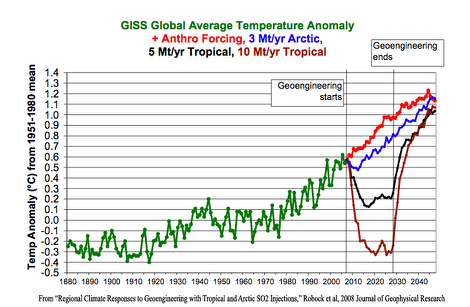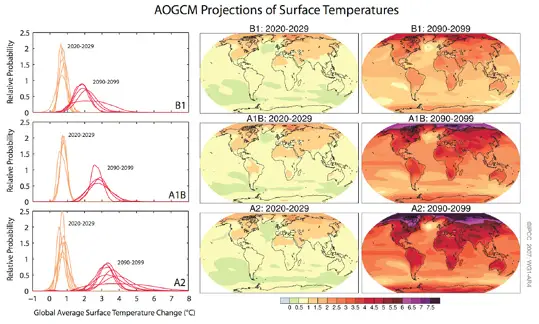Updated September 7, 2008
Amid widespread concerns about how rapidly and radically greenhouse gas emissions can be reduced, discussions of geoengineering have become more common.
David Keith, eg, Engineering the Planet, describes geoengineering as
intentional, large-scale manipulation of the environment. Both scale and intent are important.
So most changes to land and the atmosphere, such as landscaping and pollution, are excluded.
Carbon dioxide and other greenhouse gases we add to the atmosphere are warming the Earth. The increased levels of atmospheric carbon dioxide shift plant balance, for example, favoring C3 over C4 plants; C4 plants have more efficient uptake of carbon dioxide, but this becomes less important as carbon dioxide levels increase. Even worse, the ocean becomes more acidic as it absorbs much of the excess carbon dioxide added each year, with especially serious consequences for shelled organisms.
Geoengineering schemes that cool the Earth do nothing to protect ocean and land ecosystems from increased carbon dioxide.
One method would imitate volcanoes, and inject aerosols into the stratosphere.

Temperature change from sulfate injection
Unfortunately, this plan has problems: it would extend the repair of the ozone hole over Antarctica for decades, and create an ozone hole over the Arctic during particularly cold winters.
Additionally, instead of ridding the Earth of more infrared energy, sulfate aerosols block visible light, with small effects on everything from photosynthesis to solar energy. More dramatically, evaporation depends more on visible light than IR, and evaporation would decrease even if the temperature stayed constant. Decreases in rainfall are expected to be substantial in the northern tropics, particularly the Sahel and the monsoonal belts.
Policy people like David Keith see geoengineering not as a substitute for reducing greenhouse gas emissions rapidly, but an additional tool if, for example, the temperature increase for a given atmospheric level of greenhouse gas is not in the middle of the expected increase, but in the far extreme:

Projected surface temperature changes for the early and late 21st century relative to the period 1980 to 1999. Notice that uncertainty (on the left) is much greater for larger increases.
Update See also the Nature blog Climate Feedback, Geoengineering: Preparing for the Worst.
It links to a special issue of the Royal Society, Geoscale engineering to avert dangerous climate change, and a review by Stephen Schneider in that issue. He ends the review this way:
In short, my personal prescription for climate policies can be summarized in five sequenced steps.
i. Adaptation is essential now to assist those who will likely be harmed by ‘ in the pipeline’ climate change. Actions that simultaneously enhance ‘ sustainable development’ would seem the most attractive options.
ii. Performance standards required of buildings, appliances, machines and vehicles to wring the maximum potential for cost-effective engineering energy efficiency need to be mandatory and widespread.
iii. A ‘ learning-by-doing feeding frenzy’ needs to emerge, where we set up public– private partnerships to fashion incentives to help us ‘ invent our way out’ of the problem of high-emitting technological and social systems.
iv. A shadow price on carbon has to be established to ensure that the full costs of any energy production or end use system is part of the price of doing business. Cap and trade and carbon taxes are the prime examples of such schemes to internalize external risks from business-as-usual emissions, but these schemes must recognize the special problems they may pose for certain groups: poor people and coal miners or SUV workers. So, in addition to internalizing these externalities to protect the environmental commons, we need to consider side payments or other compensation schemes to be fair to the losers of the mitigation policies and to provide a transition for them to a softer economic landing, so to speak.
v. Finally, my last policy category in the sequence is to consider deploying geoengineering schemes. However, as has been said by all in this issue, and as I fully agree, R&D is needed and should be an early part of the climate policy investment sequencing, even if deployment is the last resort.



I think criticisms of geoengineering boil down to the very valid point that you shouldn’t try to fix what ain’t broken.
Marshall, thanks for checking in.
I’m confused. Why do you think that the climate isn’t broken, at least for species that evolved in the last few tens of millions of years?
There is NO analysis accepted by Intergovernmental Panel on Climate Change that shows us keeping atmospheric levels of greenhouse gas low enough to produce a temperature increase less than a best estimate of 2°C. And a best estimate of 2°C still means a 50% chance of more than 2°C, with a very real possibility of much greater than 2°C.
It looks like, even if people worldwide get our act together pretty soon, there’s a decent chance that we will be comparing the costs of geoengineering for regions expected to be most affected, a damaged ozone layer, etc versus the benefits of decreasing the worldwide temperature by more than 1°C.
If it comes to that, all options are awful.
I’m not saying the climate isn’t broken. I’m saying, the chemical balance of the seas ain’t broken in a way that adding iron oxide would fix. The transparency of the air ain’t broken in a way that adding particulate pollution would fix. Et cetera. If the climate is broken, fix the climate. Don’t break a second thing in hopes that two broken things will make one whole.
I say that we should prove that we’re smart enough to stop the UNINTENTIONAL amping up of the system before we contemplate trying to intentionally alter it (which is only required because we’re apparently not smarter than yeast and fully do intend to kill ourselves with our own excreta).
JMG, I agree that any society irresponsible enough to continue adding GHG at the current and (immediate) future rate is not a society I would trust to make hard decisions about geoengineering.
Also, I want to make it clear that I often report what scientists and policy experts are discussing. I don’t support or oppose the geoengineering proposals, though I would definitely not want to be one of the people making decisions about relative evils and whether to use it. It IS important to know that top people are seriously considering them. For me, it’s another way of hearing how dangerous changing the climate is.
I hope the proposals never need be used.